
Maltipoos, the gorgeous little mix of Maltese and Poodles, are loved for their friendly, playful nature and fluffy teddy bear looks. If you’re thinking about adding one of these cutie dogs to your family, you might be asking: Do Maltipoos shed?
While Maltipoos are generally considered low-shedding dogs, they do shed a bit, and the amount can vary even between dogs of the same litter. This guide will give you clear, practical information on what to expect regarding Maltipoo shedding, how to manage it, and the best practices for keeping their coats healthy.
From grooming techniques and diet tips to understanding their coat types, you’ll find all the information you need to keep your Maltipoo looking great and your home clean. Let’s explore everything about Maltipoo shedding habits and how to manage them effectively.
Table of Contents
- Do Maltipoos Shed?
- Understanding Maltipoo Coat Types
- Factors Affecting Maltipoo Shedding
- Are Maltipoos Hypoallergenic?
- Grooming Your Maltipoo to Control Shedding
- Diet and Nutrition's Impact on Maltipoo Shedding
- Dealing with Excessive Shedding
- Seasonal Shedding in Maltipoos
- Managing Allergies Triggered by Maltipoos
- How to Choose a Low-Shedding Maltipoo
- Final Thoughts
Do Maltipoos Shed?
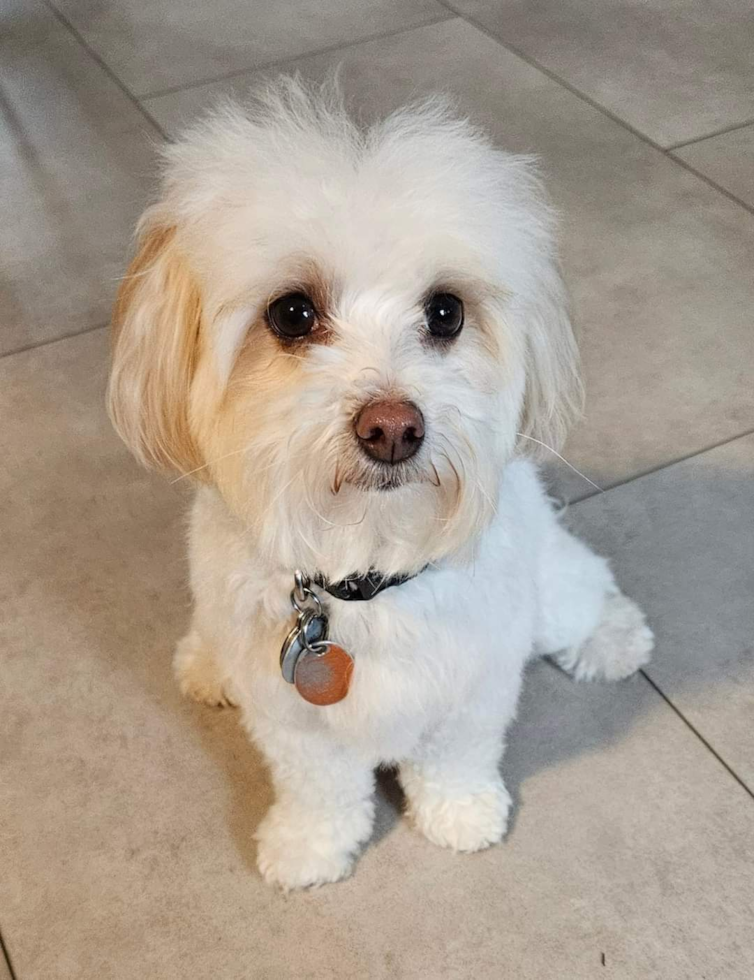
Premier Pups Customer Photo of a low-shedding Maltipoo
Maltipoos are often touted as low-shedding dogs. But what does this really mean? To understand if Maltipoos shed, we need to look at their unique coat and genetics.
Maltipoos inherit their coat characteristics from their parent breeds: the Maltese and the Poodle. Both of these breeds are known for their minimal shedding. Maltese have a single-layer coat that doesn't shed much, while Poodles are famous for their hypoallergenic, curly coats that trap shed hair instead of letting it fall out. As a result, Maltipoos tend to shed less than many other breeds, but they are not entirely shed-free.
Understanding Maltipoo Coat Types
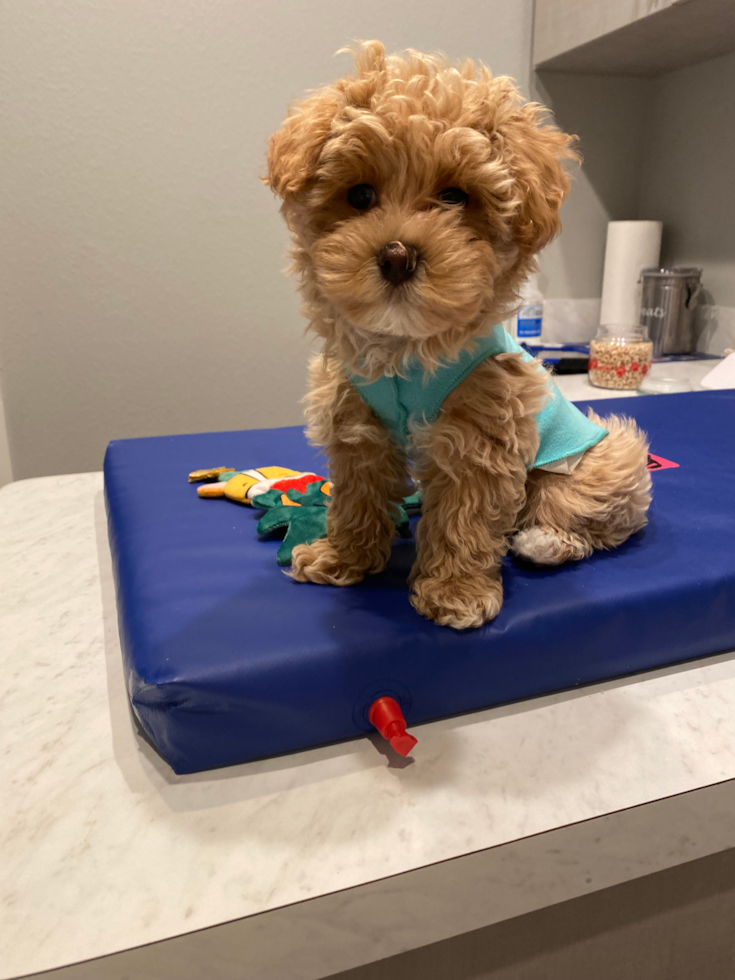
Premier Pups Customer Photo of a low-shedding Maltipoo
The texture and shedding tendencies of a Maltipoo's coat can vary widely, primarily influenced by their genetic makeup. Here are the three main coat types you might encounter with a Maltipoo:
Curly Coat
The curly coat is most similar to that of a Poodle. These tight curls do an excellent job of trapping shed hair, which means that Maltipoos with curly coats are typically the lowest shedders. This coat type requires regular grooming to prevent matting and tangling, but the shedding is minimal, making it ideal for allergy sufferers.
Wavy Coat
A wavy coat is a blend of both the Maltese and Poodle coat types. It’s not as tightly curled as a Poodle's coat but has more wave than a Maltese's straight hair. This type of coat may shed slightly more than a curly coat but still tends to be low shedding compared to other breeds. Regular brushing is essential to keep the coat free of tangles and to remove any loose hair.
Straight Coat
The straight coat resembles the Maltese coat the most. It is soft and silky, and while it may shed more than the other two types, it is still relatively low shedding. This coat type benefits from frequent brushing to manage shedding and maintain its smooth texture.
RELATED: Complete Guide to All Maltipoo Colors
Factors Affecting Maltipoo Shedding
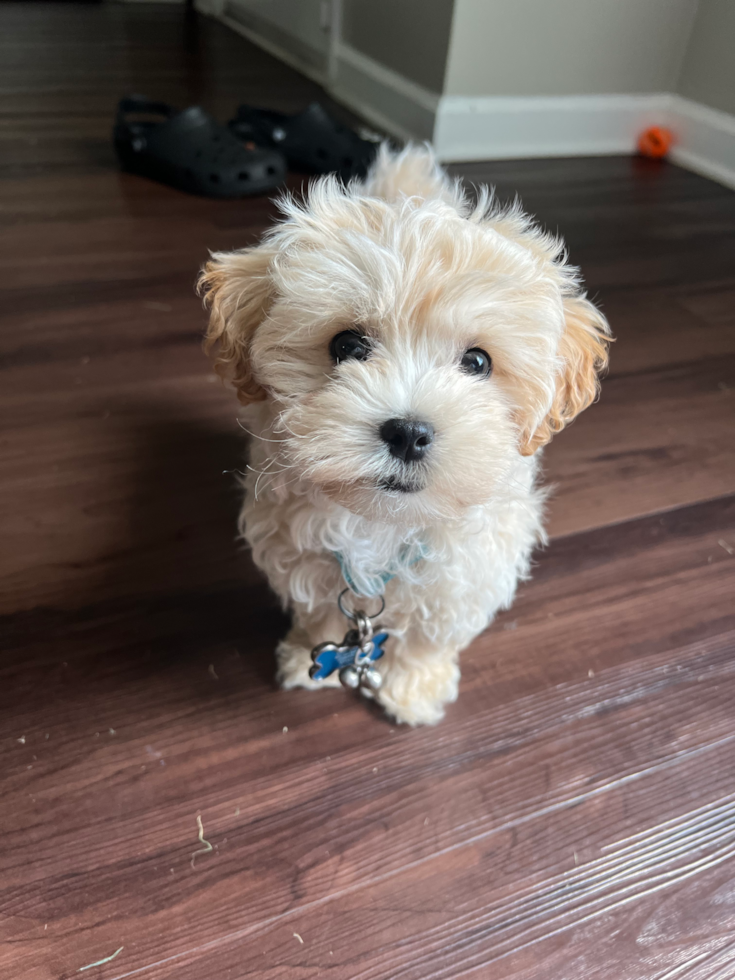
Premier Pups Customer Photo of a low-shedding Maltipoo
While Maltipoos are generally low-shedding dogs, several factors can influence how much they shed. Understanding these factors can help you manage and minimize shedding more effectively. Here are the key factors affecting Maltipoo shedding:
Genetics
Genetics play a significant role in determining a Maltipoo’s shedding habits. Depending on whether a Maltipoo inherits more traits from the Poodle or the Maltese parent, their coat type and shedding levels can vary. Typically, those with more Poodle-like coats shed less due to the curly nature of their fur, which traps loose hairs.
Age
The age of your Maltipoo can also impact shedding. Puppies generally have a different coat than adult dogs and may shed their puppy coat as they mature. This shedding is usually temporary and should stabilize once the adult coat fully develops. Older Maltipoos might also experience changes in their coat texture and shedding patterns as they age.
Health Conditions
Health issues such as skin infections, allergies, or hormonal imbalances can lead to excessive shedding in Maltipoos. Ensuring your dog is in good health through regular vet check-ups can help identify and address any underlying health problems that may contribute to increased shedding.
Seasonal Changes
Like many dogs, Maltipoos can shed more during seasonal transitions. As the weather changes from winter to summer or summer to winter, you might notice an increase in shedding as they adjust to the new temperatures. Regular grooming during these periods can help manage the extra shedding.
Diet and Nutrition
A balanced diet rich in essential nutrients can significantly affect the health of your Maltipoo’s coat. Omega-3 and Omega-6 fatty acids, in particular, are known to promote a healthy, shiny coat and reduce shedding.
Grooming Routine
A regular grooming routine is essential for managing shedding. Brushing your Maltipoo’s coat several times a week helps remove loose hairs before they fall out and keeps their coat looking tidy.
Additionally, regular baths and professional grooming sessions can help maintain the coat’s health and minimize shedding.
RELATED: 20 Pros and Cons of Owning a Maltipoo
Are Maltipoos Hypoallergenic?
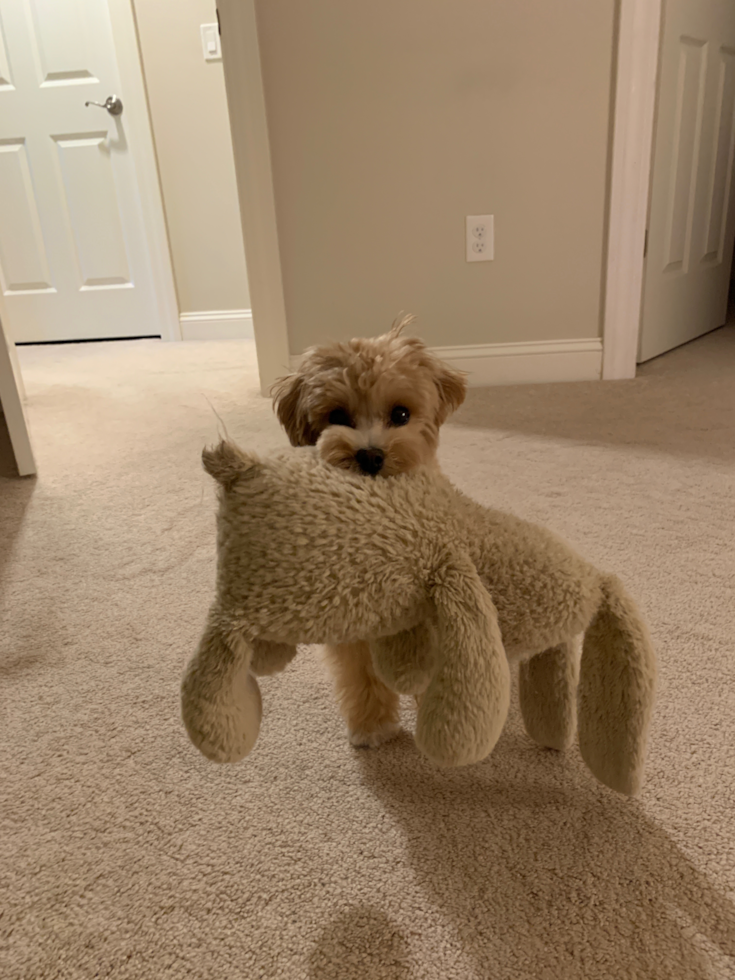
Premier Pups Customer Photo of a low-shedding Maltipoo
One of the appealing traits of Maltipoos is their reputation as hypoallergenic dogs. But what does hypoallergenic really mean, and how does it apply to Maltipoos?
What Does Hypoallergenic Mean?
Hypoallergenic dogs are breeds that are less likely to cause allergic reactions in people who are sensitive to pet dander. Dander, which consists of tiny skin flakes shed by pets, is a common allergen. Additionally, proteins found in a dog’s saliva and urine can also trigger allergies when they are spread to fur and then shed into the environment.
How Maltipoos Compare to Other Breeds
Maltipoos tend to be more hypoallergenic than many other breeds due to their low-shedding coats. Both parent breeds, the Maltese and the Poodle, are known for their hypoallergenic properties. Maltese have hair-like fur that doesn’t shed much, while Poodles have curly coats that trap dander and shed hair.
Since Maltipoos typically inherit these coat characteristics, they produce less dander and shed less fur, making them a suitable option for people with mild allergies. However, it’s essential to understand that no dog breed is entirely hypoallergenic. Even Maltipoos can cause allergic reactions in some individuals, particularly those with severe allergies.
Managing Allergies with a Maltipoo
For allergy sufferers, managing allergies effectively is crucial. Here are some tips to reduce allergen exposure:
- Regular Grooming: Frequent brushing and bathing help minimize loose fur and dander in the environment.
- Clean Living Space: Regularly vacuuming and dusting your home can significantly reduce allergens. Consider using air purifiers to keep the air clean.
- Personal Hygiene: Wash your hands after petting your Maltipoo and avoid touching your face to prevent allergens from transferring.
- Allergy Medications: Consult with an allergist about medications or treatments that can help manage symptoms.
RELATED: Are Maltipoos Hypoallergenic?
Grooming Your Maltipoo to Control Shedding
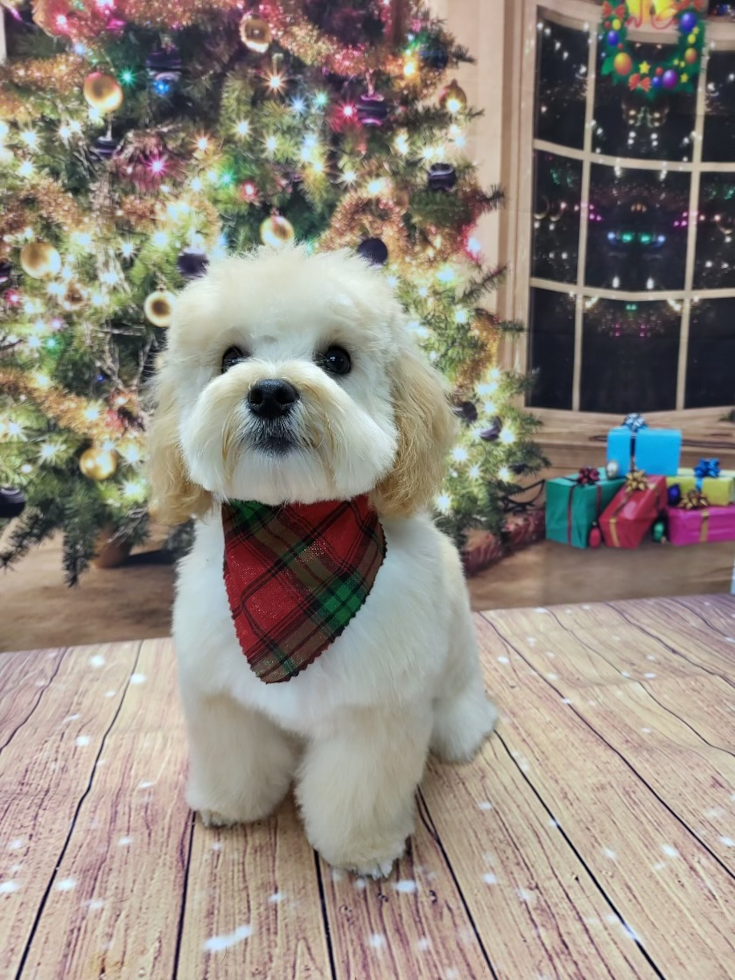
Premier Pups Customer Photo of a low-shedding Maltipoo
Proper grooming is essential for managing your Maltipoo’s shedding and keeping their coat healthy. Here are some effective grooming techniques and tools to help you keep your Maltipoo's shedding under control.
Brushing Techniques
Regular brushing is a must for Maltipoos, especially those with curly or wavy coats. Brushing helps remove loose hairs, prevents matting, and distributes natural oils throughout the coat, which keeps the fur healthy and shiny. Aim to brush your Maltipoo at least 2-3 times a week. For curly coats, use a slicker brush or a pin brush to detangle knots gently. For wavy or straight coats, a bristle brush works well to remove loose hair and smooth the fur.
Recommended Grooming Tools
Using the right tools can make a significant difference in your grooming routine. Here are some essential grooming tools for Maltipoos:
- Slicker Brush: Ideal for removing tangles and loose hairs in curly coats.
- Pin Brush: Perfect for wavy coats, helps to detangle and smooth.
- Bristle Brush: Suitable for straight coats, removes loose hair and distributes oils.
- Comb: A fine-toothed comb helps remove any remaining tangles and loose hairs after brushing.
- Grooming Scissors: Useful for trimming around the eyes, ears, and paws.
- Detangling Spray: Helps ease brushing and reduce breakage.
Professional Grooming vs. DIY
While regular at-home grooming is essential, professional grooming can be a valuable addition to your Maltipoo's care routine. Professional groomers have the expertise and equipment to give your dog a thorough grooming, including bathing, trimming, and styling. Aim for a professional grooming session every 4-6 weeks, depending on your Maltipoo's coat type and growth rate.
DIY grooming, on the other hand, can help maintain your Maltipoo’s coat between professional sessions. Make sure to familiarize yourself with proper grooming techniques and take your time to avoid any accidental nicks or cuts.
Regular Baths
Bathing your Maltipoo regularly helps keep their coat clean and reduces shedding. Use a mild dog shampoo formulated for sensitive skin, and avoid over-bathing, as it can dry out their skin and increase shedding. Bathing every 4-6 weeks is generally sufficient. Always dry your Maltipoo thoroughly after a bath to prevent moisture from causing skin issues or matting.
RELATED: How Often Should You Bathe Your Dog? A Comprehensive Guide
Diet and Nutrition's Impact on Maltipoo Shedding
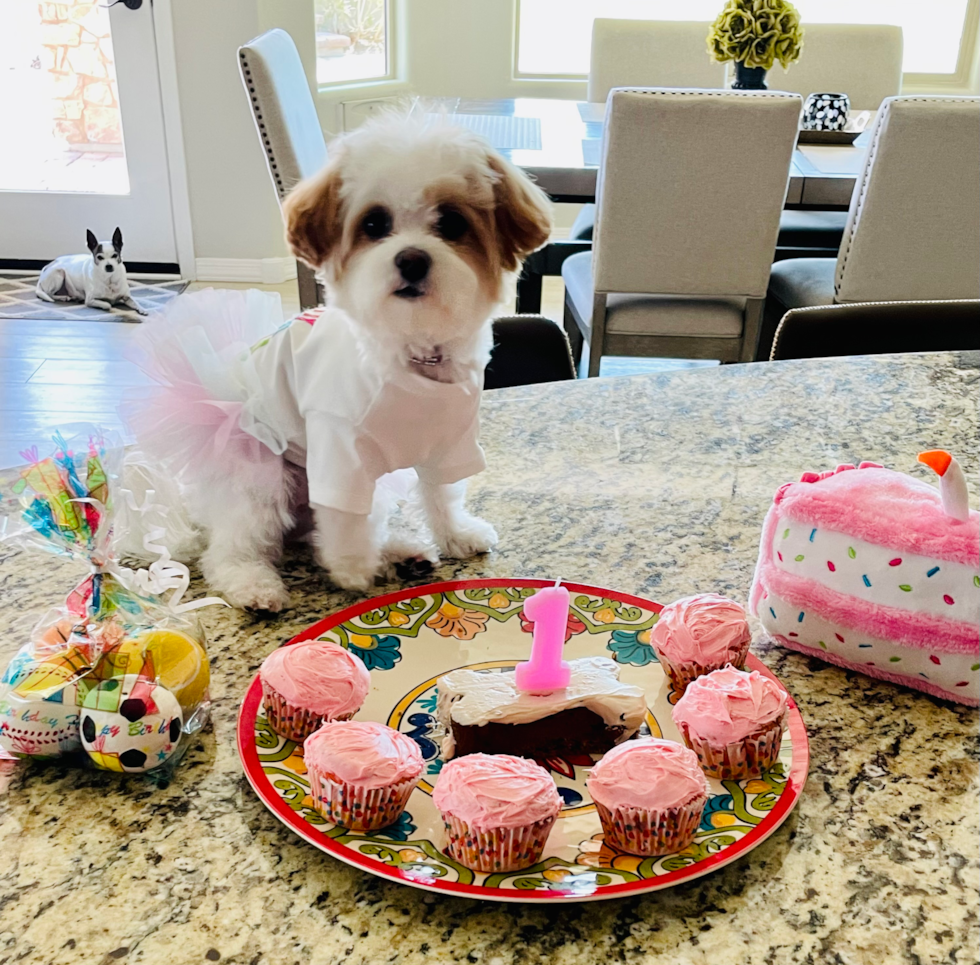
Premier Pups Customer Photo of a low-shedding Maltipoo
A balanced diet plays a significant role in the overall health of your Maltipoo’s coat and can greatly impact shedding. Providing your Maltipoo with the right nutrients ensures their coat remains shiny, strong, and less prone to shedding. Here are some key dietary considerations to help manage and minimize shedding:
Essential Nutrients
Certain nutrients are crucial for maintaining a healthy coat:
- Omega-3 and Omega-6 Fatty Acids: These essential fatty acids are vital for skin and coat health. They help reduce inflammation, promote a glossy coat, and minimize shedding. Sources include fish oil, flaxseed, and high-quality commercial dog foods that list these nutrients.
- Protein: High-quality protein is essential for hair growth and repair. Ensure your Maltipoo's diet includes lean meats, fish, and eggs.
- Vitamins and Minerals: Vitamins such as A, E, and B-complex, along with minerals like zinc and biotin, support skin health and coat strength. Look for dog foods that are fortified with these vitamins and minerals.
Recommended Dog Foods
Choosing the right dog food can make a big difference in your Maltipoo’s coat health. Opt for premium dog foods that list high-quality protein sources as the main ingredient and include essential fatty acids, vitamins, and minerals. Some brands specifically formulate their products to promote skin and coat health, which can be beneficial for reducing shedding.
Supplements to Reduce Shedding
If your Maltipoo's diet lacks certain nutrients, consider adding supplements to their routine. Fish oil capsules, flaxseed oil, and specialized coat supplements can help improve coat health and reduce shedding. Always consult your veterinarian before introducing any new supplements to ensure they are appropriate for your dog.
Hydration
Proper hydration is another key factor in maintaining a healthy coat. Make sure your Maltipoo has access to fresh water at all times. Dehydration can lead to dry skin, which in turn can cause increased shedding.
Avoiding Allergens
Food allergies can contribute to skin irritation and excessive shedding. If you notice your Maltipoo has sensitive skin or is shedding more than usual, it might be worth exploring potential food allergies. Common allergens include grains, dairy, and certain proteins. A hypoallergenic dog food or an elimination diet, under veterinary supervision, can help identify and mitigate food-related shedding issues.
Dealing with Excessive Shedding
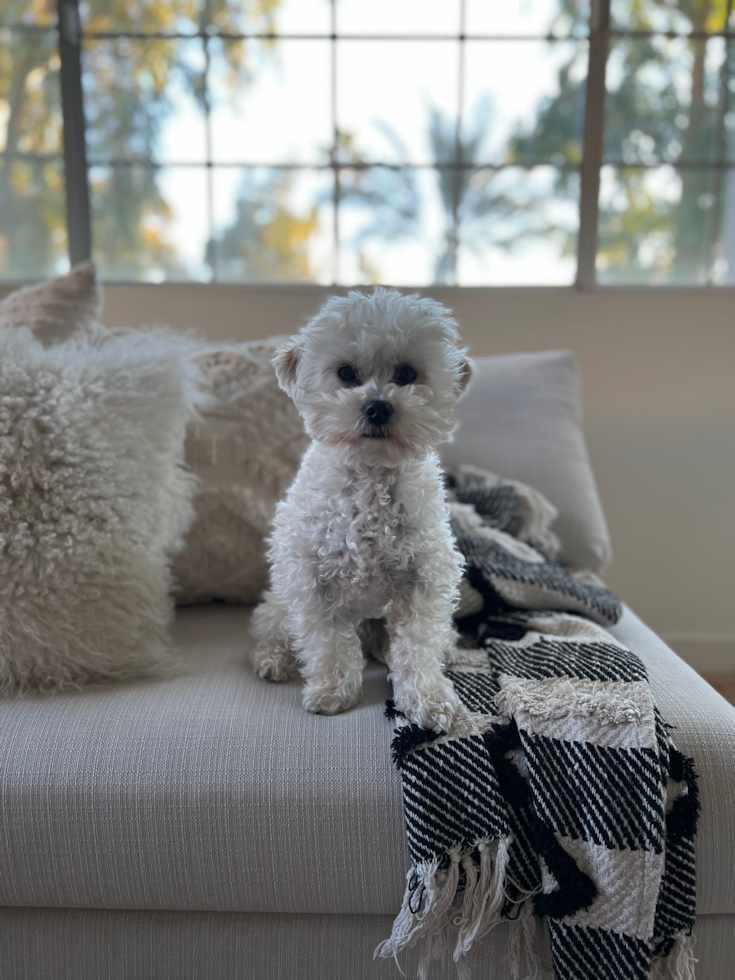
Premier Pups Customer Photo of a low-shedding Maltipoo
There may be times when you notice an unusual amount of shedding in your Maltipoo. Here are some strategies for dealing with excessive shedding and when to seek veterinary advice.
Identifying Underlying Health Issues
Excessive shedding can often be a sign of underlying health problems. Conditions such as allergies, skin infections, parasites, or hormonal imbalances can all contribute to increased shedding. If you notice excessive shedding along with other symptoms like itching, redness, or changes in behavior, it’s essential to consult your veterinarian. They can conduct tests to diagnose any health issues and recommend appropriate treatments.
Environmental Factors
Environmental changes can also affect your Maltipoo’s shedding. Factors such as changes in climate, humidity, or exposure to allergens can lead to increased shedding. Keeping your home clean, using air purifiers, and maintaining a comfortable living environment can help reduce the impact of these factors.
Stress and Anxiety
Stress and anxiety can contribute to excessive shedding in dogs. Ensuring your Maltipoo has a stable routine, plenty of exercise, and mental stimulation can help reduce stress levels. Consider providing a safe and comfortable space for your dog to relax and consult your vet if you think anxiety might be causing excessive shedding.
When to Consult a Vet
If you’ve tried managing shedding through grooming, diet, and environmental adjustments but still notice excessive shedding, it’s time to consult your vet. Persistent shedding can be a sign of more serious health issues that require professional intervention. Your vet can conduct a thorough examination and provide treatments or recommendations to address the underlying causes of excessive shedding.
Seasonal Shedding in Maltipoos
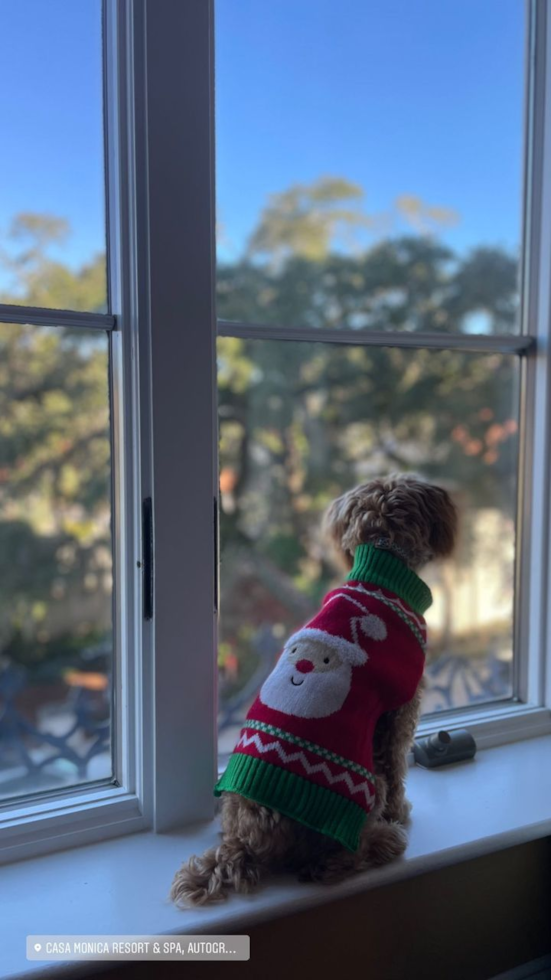
Premier Pups Customer Photo of a low-shedding Maltipoo
Maltipoos can experience variations in shedding patterns due to seasonal changes. Here’s what you need to know about seasonal shedding in Maltipoos:
Winter to Summer Transition
As the weather warms up from winter to summer, Maltipoos may shed their winter coats to adapt to the increasing temperatures. This period, often referred to as "blow coat," can result in an increase in shedding as your dog loses the thicker fur that kept them warm during the colder months. To manage this seasonal shedding:
- Increase Brushing: During the transition period, brush your Maltipoo more frequently to remove loose hairs and prevent matting. Daily brushing can significantly reduce the amount of hair shed around your home.
- Regular Baths: Bathing your Maltipoo with a gentle shampoo can help remove excess fur and keep their coat clean. Ensure thorough drying to prevent any skin issues.
RELATED Expert Tips on Keeping Your Dog Safe During Heatwavess
Summer to Winter Transition
As summer turns to winter, Maltipoos may grow a thicker coat to provide additional warmth. Although this coat change is typically less dramatic than the winter-to-summer transition, you may still notice some shedding. To handle this:
- Maintain Grooming Routine: Continue regular grooming to manage any shedding and keep the coat healthy. Adjust the frequency of grooming based on the thickness of your Maltipoo’s coat.
- Proper Nutrition: Ensure your Maltipoo receives a balanced diet rich in essential nutrients to support a healthy coat during the seasonal change.
RELATED: 10 Winter Care Tips For Dog Owners
Shedding Triggers
Apart from seasonal changes, several other factors can influence shedding patterns in Maltipoos:
- Indoor Environment: Dogs that spend a lot of time indoors may not experience as pronounced seasonal shedding as those that spend more time outdoors, due to a more consistent indoor temperature.
- Lighting: Exposure to natural light can influence shedding cycles. Dogs with more access to natural sunlight may have more distinct shedding periods.
Managing Allergies Triggered by Maltipoos
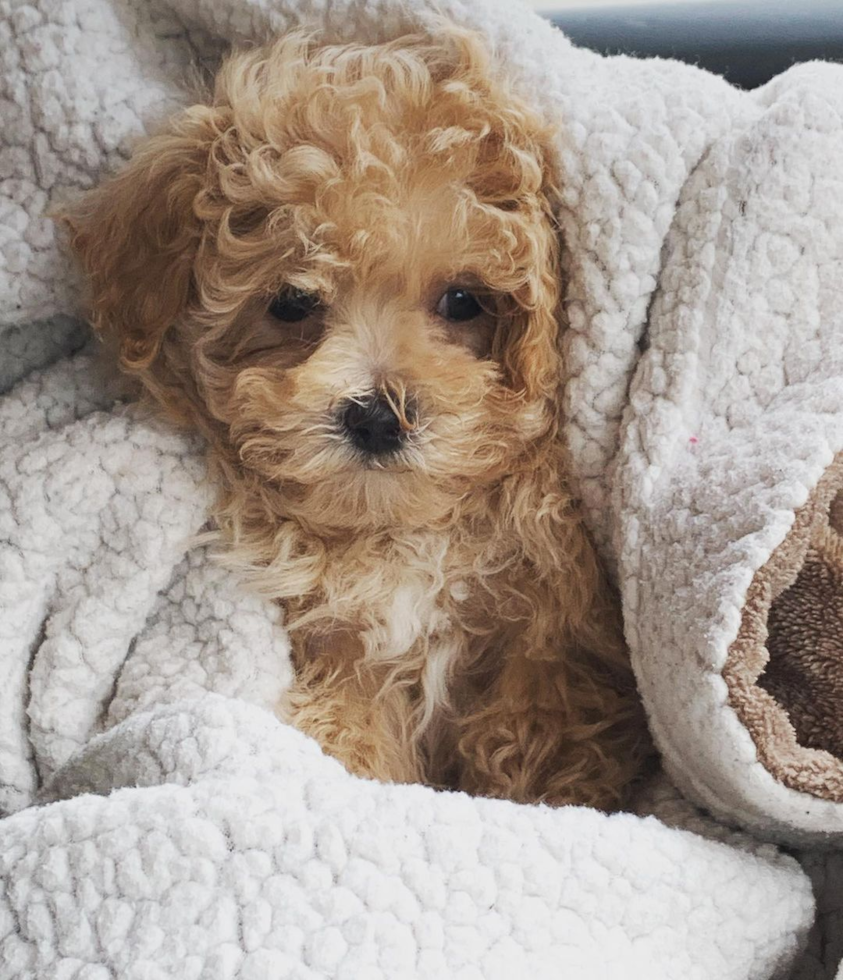
Premier Pups Customer Photo of a low-shedding Maltipoo
It's important to understand that no dog is completely hypoallergenic. Here’s how to manage allergies effectively if you have a Maltipoo and are seeing allergic reactions:
Tips for Allergy Sufferers
- Regular Grooming: Keeping your Maltipoo well-groomed is crucial. Regular brushing reduces the amount of loose fur and dander in your home. Aim for at least two to three times a week.
- Frequent Baths: Bathing your Maltipoo regularly helps minimize allergens. Use a gentle dog shampoo that won’t dry out their skin. Bathing every four to six weeks is generally sufficient.
- Clean Living Spaces: Keep your home clean by vacuuming regularly with a vacuum designed to handle pet hair and dander. Consider using air purifiers to reduce airborne allergens.
Home Cleaning Tips
- Vacuuming: Use a vacuum with a HEPA filter to capture pet dander and hair. Vacuum carpets, rugs, and upholstery frequently.
- Dusting: Regularly dust surfaces to prevent the accumulation of allergens. Use a damp cloth to avoid stirring up dust.
- Washing Linens: Wash your dog’s bedding, as well as your own, frequently in hot water to remove dander. Use hypoallergenic detergents to further reduce allergens.
Allergy Medications and Treatments
- Over-the-Counter Options: Antihistamines such as cetirizine (Zyrtec) or loratadine (Claritin) can help manage mild allergy symptoms.
- Prescription Medications: For more severe allergies, consult your doctor. They may prescribe stronger medications or suggest allergy shots (immunotherapy) to reduce sensitivity to pet allergens.
Allergy Testing
If you suspect that your Maltipoo is causing allergies, consider getting tested. An allergist can perform tests to determine what specific allergens trigger your symptoms. This can help you develop a targeted approach to managing your allergies.
Creating a Pet-Free Zone
Designate certain areas of your home as pet-free zones, such as bedrooms. This provides a space where you can avoid exposure to allergens and reduce the risk of symptoms while you sleep.
Personal Hygiene
- Hand Washing: Always wash your hands after handling your Maltipoo to remove any allergens.
- Changing Clothes: If you've been playing with or grooming your dog, consider changing clothes to avoid spreading allergens around your home.
Consultation with an Allergist
For persistent or severe allergies, consult an allergist. They can provide personalized advice and treatment plans to help you manage your symptoms effectively.
How to Choose a Low-Shedding Maltipoo
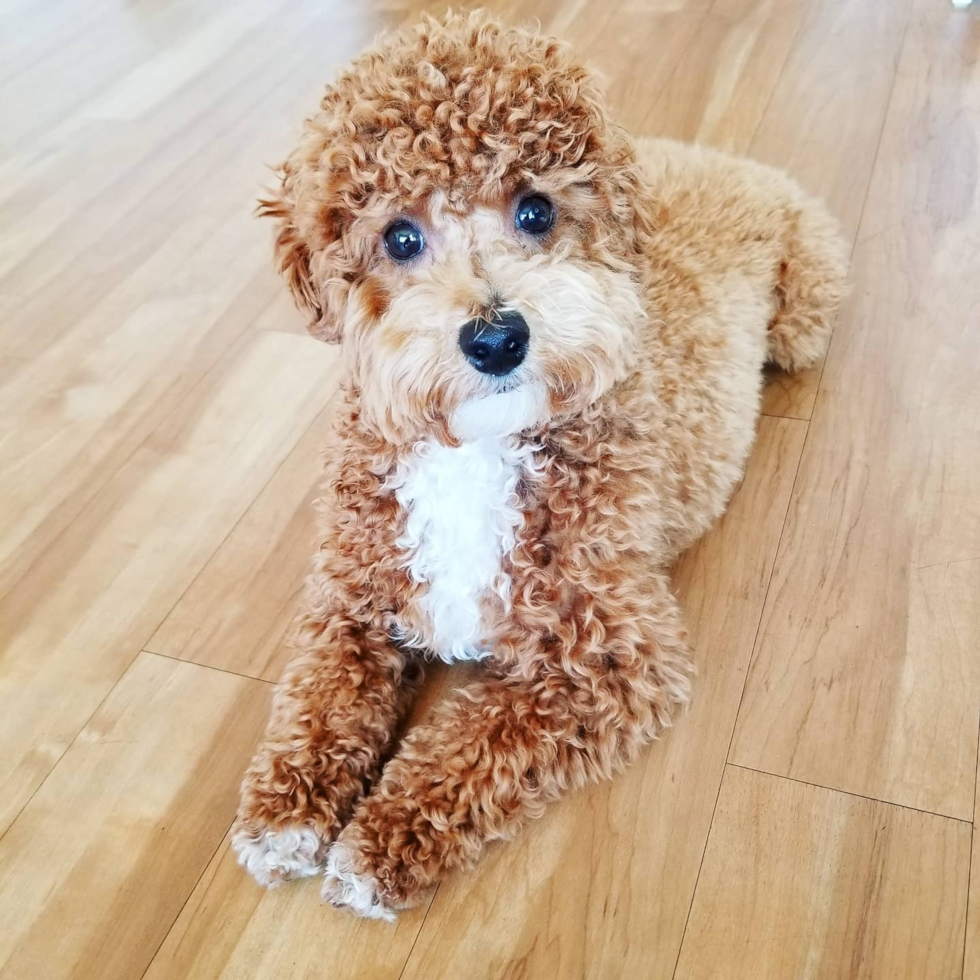
Premier Pups Customer Photo of a low-shedding Maltipoo
When looking to add a Maltipoo to your family, choosing one that sheds minimally can be a priority, especially for those with allergies or a preference for a cleaner home. Here are some tips to help you select a low-shedding Maltipoo:
Selecting the Right Generation
Maltipoos come in different generations, which can influence their coat type and shedding levels. Here’s a breakdown of the generations:
- F1 Maltipoo: First-generation Maltipoos are a 50/50 mix of Maltese and Poodle. Their coat type can vary, and they may shed slightly more if they inherit more traits from the Maltese parent.
- F1b Maltipoo: This generation is a cross between an F1 Maltipoo and a Poodle, resulting in 75% Poodle genetics. F1b Maltipoos are more likely to have a curly, low-shedding coat similar to that of a Poodle.
- F2 Maltipoo: Second-generation Maltipoos are the offspring of two F1 Maltipoos. Their coat type and shedding levels can be less predictable but generally remain low-shedding.
Choosing an F1b or higher generation Maltipoo increases the likelihood of a low-shedding coat due to the higher percentage of Poodle genetics.
Breeder Tips
Selecting a reputable breeder is crucial in ensuring you get a healthy, low-shedding Maltipoo. Here are some tips:
- Research Breeders: Look for breeders with positive reviews and a strong reputation.
- Health Testing: Ensure the breeder conducts health tests on the parent dogs. This helps in reducing the risk of genetic health issues that could affect your Maltipoo’s coat and overall health.
RELATED: See our low-shedding Maltipoo puppies for sale
Coat Assessment
When choosing a puppy, pay attention to the coat type:
- Curly Coats: Puppies with curly coats are more likely to be low-shedding. Look for tight, springy curls similar to those of a Poodle.
- Wavy Coats: Wavy coats are also relatively low-shedding, though slightly more than curly coats. Look for soft, loose waves.
- Straight Coats: Straight-coated puppies may shed more than curly or wavy ones. They still shed less than other dog breeds but may not be ideal for severe allergy sufferers.
Puppy Selection
Spend time with the puppies to assess their temperament and coat type. Ask the breeder about the shedding characteristics of previous litters, if available. Observing the puppies in different settings can give you an idea of their grooming needs and potential shedding levels.
RELATED: 7 Ways to Identify a Responsible Breeder
Final Thoughts
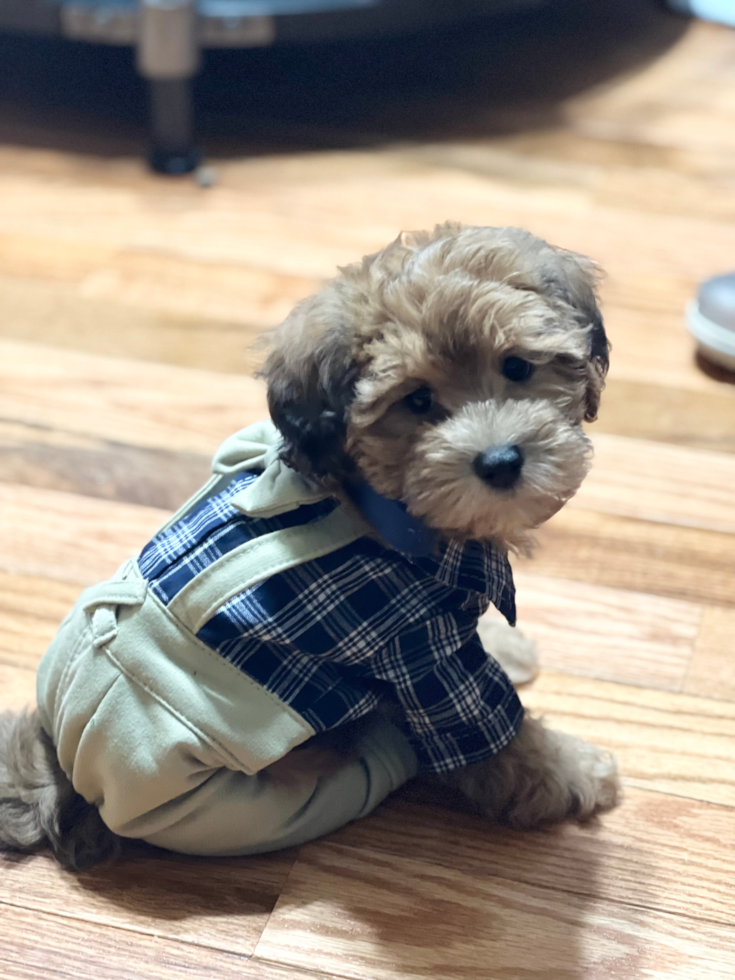
Premier Pups Customer Photo of a low-shedding Maltipoo
Maltipoos are a fantastic choice for those seeking a low-shedding, affectionate companion. While they shed less than other breeds, regular grooming, a balanced diet, and proper exercise are key to managing their coat and keeping shedding to a minimum. By understanding their unique needs and following the tips in this guide, you can ensure your Maltipoo stays healthy and happy, with a beautifully maintained coat.
Scroll down to see FAQs about Maltipoo Shedding
What To Read Next
Are Maltipoos Hypoallergenic?
Meet The Unique Black and Brown Maltipoo
Frequently Asked Questions
Do Maltipoos shed a lot? Maltipoos are generally low-shedding dogs. They inherit this trait from both the Maltese and Poodle breeds, which are known for their minimal shedding. While they do shed, the amount is significantly less compared to many other dogs.
Are Maltipoos hypoallergenic? Maltipoos are often considered hypoallergenic because they shed less dander, which is a common allergen. However, no dog is completely hypoallergenic. People with severe allergies may still react to Maltipoos, so it's important to spend time with the breed before deciding to reserve.
How can I reduce shedding in my Maltipoo? To minimize shedding, maintain a regular grooming routine. Brush your Maltipoo several times a week to remove loose hairs and prevent matting. Regular baths with a gentle shampoo and a balanced diet rich in omega fatty acids also help reduce shedding. If excessive shedding occurs, consult your veterinarian to rule out any health issues.
Do Maltipoo puppies shed more than adults? Maltipoo puppies may shed their puppy coat as they mature, usually around the age of 10 months. This shedding is temporary and generally less noticeable. Once the adult coat comes in, shedding will decrease and become more consistent.
What type of coat sheds the least in Maltipoos? Maltipoos with curly coats, which resemble the Poodle parent, tend to shed the least. The curls trap loose hairs, preventing them from falling out as much. Wavy coats shed slightly more but are still relatively low-shedding. Straight coats may shed more than the other types but are still manageable with regular grooming.




